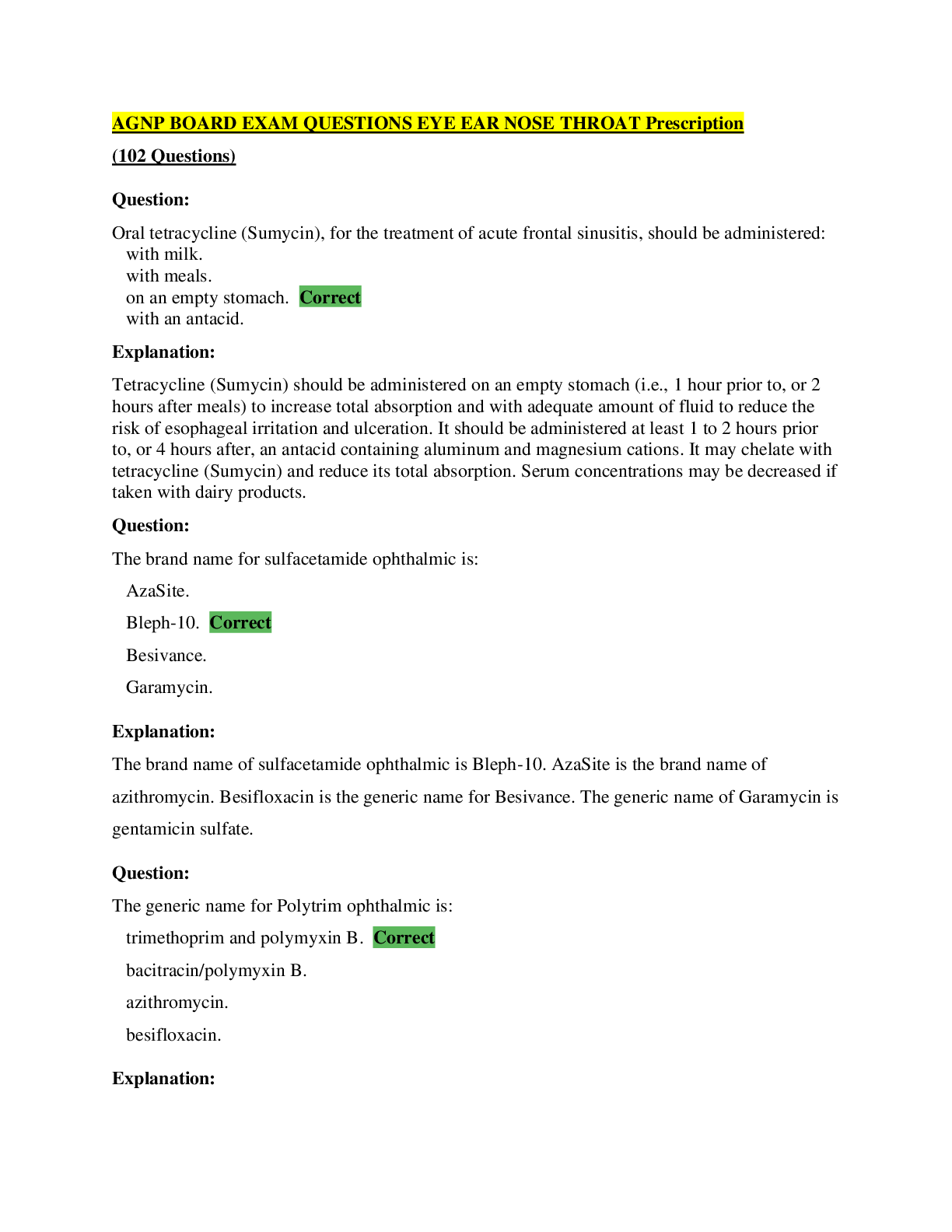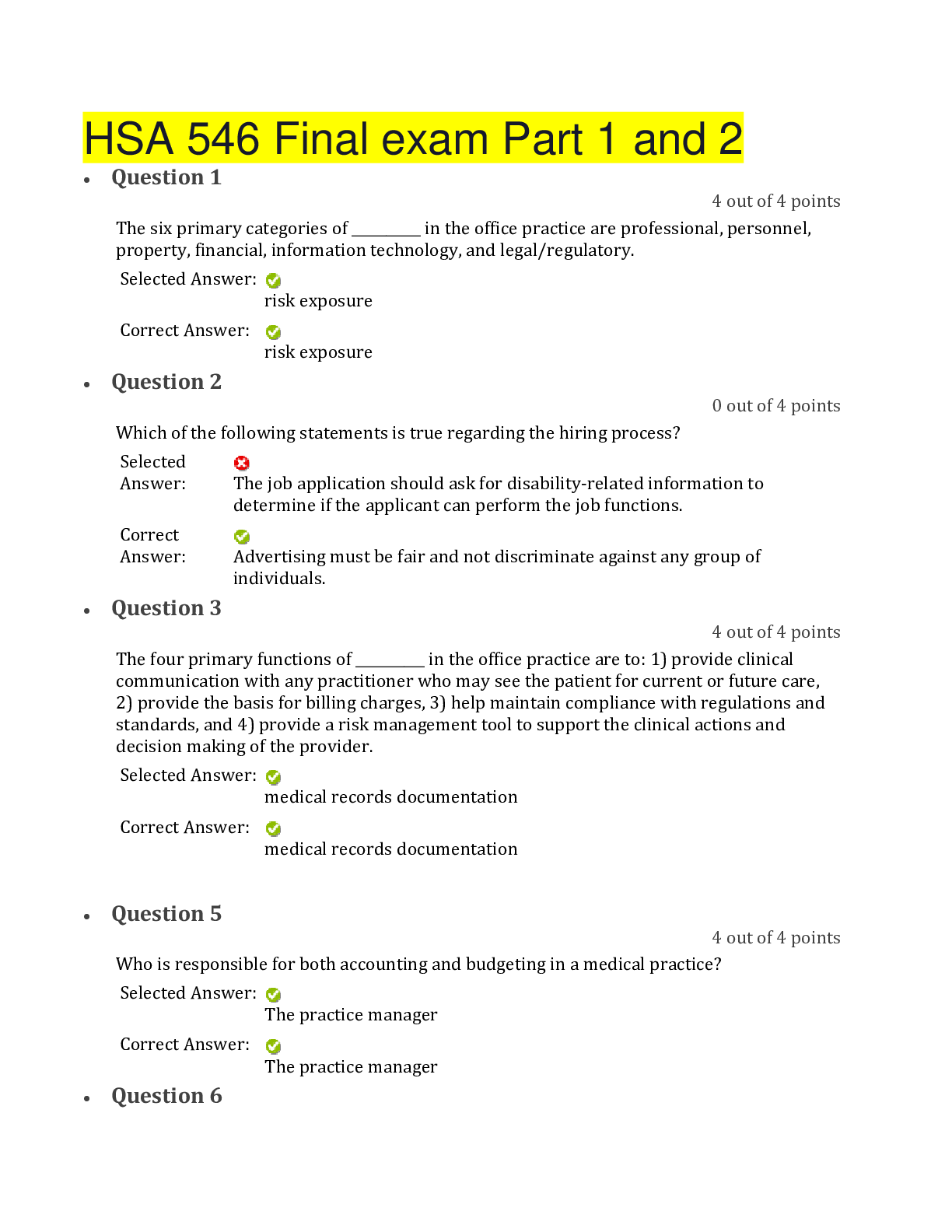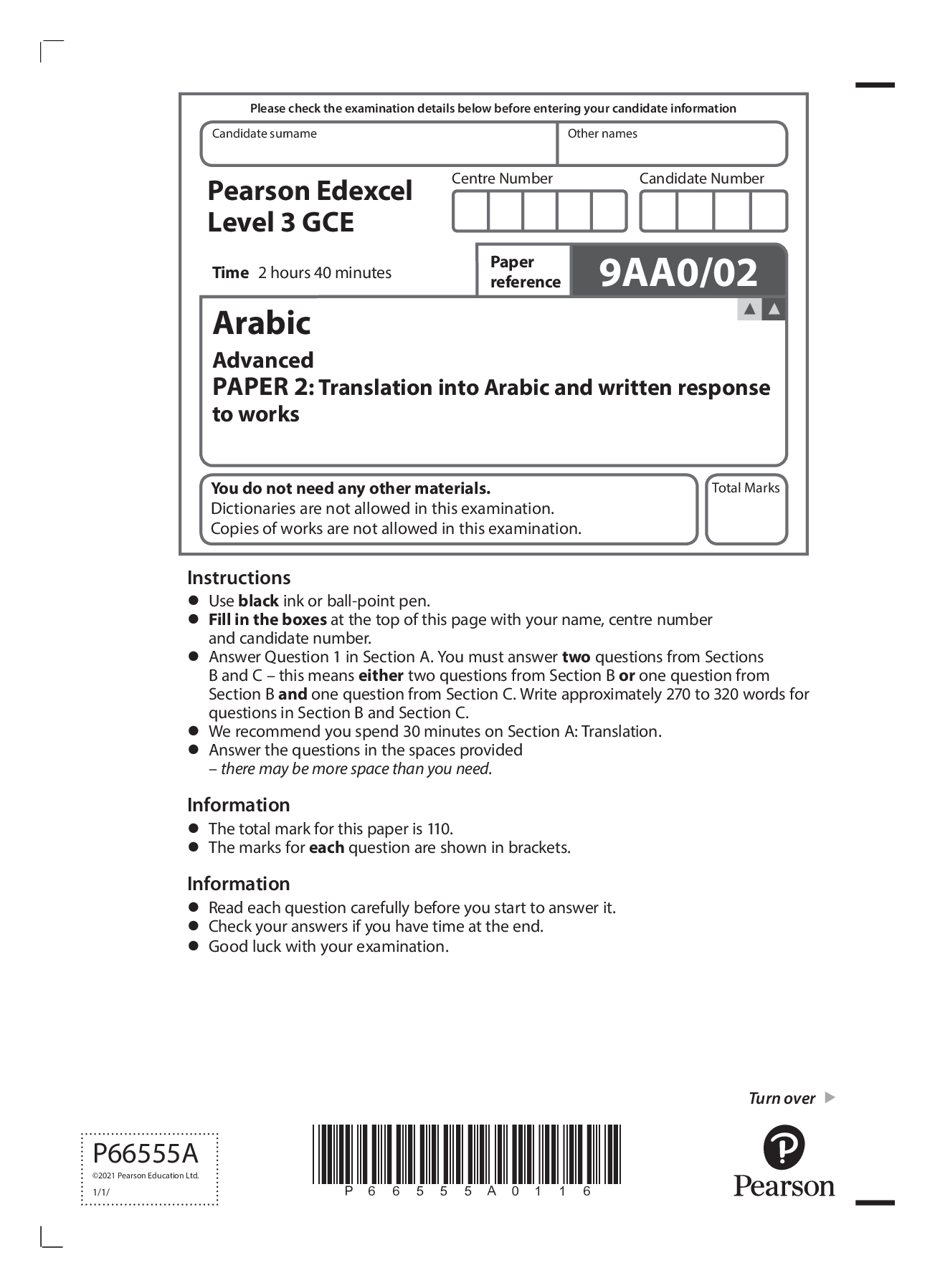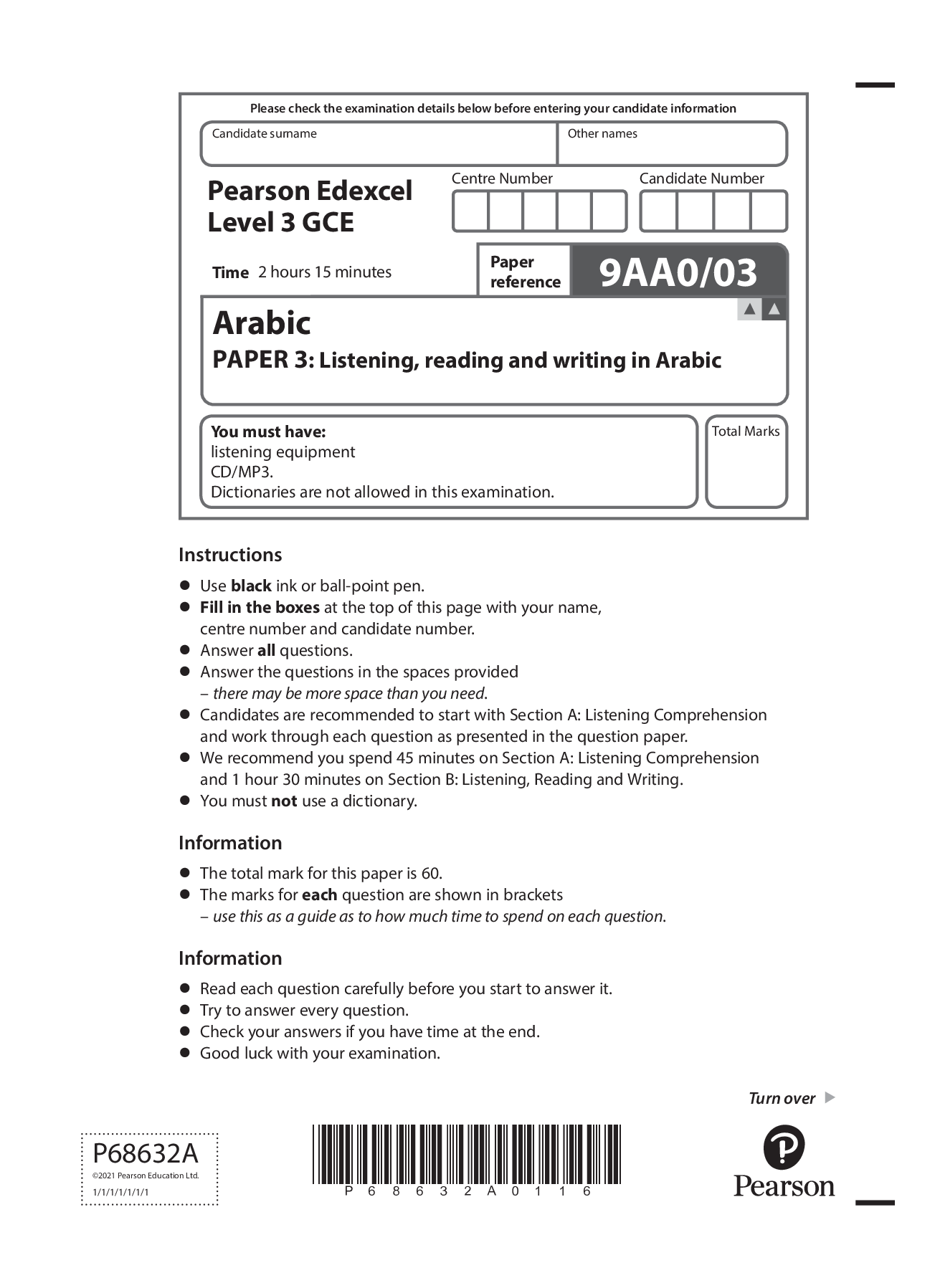AGNP BOARD EXAM QUESTIONS (Dermatoloy) ;64 questions and answers
Document Content and Description Below
AGNP BOARD EXAM QUESTIONS (Dermatoloy) ;64 questions and answers Question: A reddish blue, irregularly shaped, solid and spongy mass of blood vessels that may be present at birth and enlarge during ... the first 10 to 15 months is characteristic of a: cavernous hemangioma. Correct strawberry mark. telangiectasia. port-wine stain. Explanation: A cavernous hemangioma appears as a reddish blue, irregularly shaped, solid and spongy mass of blood vessels. It may be present at birth, may enlarge during the first 10 to 15 months, and will not involute spontaneously. A port-wine stain is a large, flat, macular dark red or purplish patch covering the scalp or face, frequently along the distribution of cranial nerve V and intensifies with crying, exertion, or exposure to heat or cold. A strawberry mark is a type of hemangioma that has a raised bright red area with well-defined borders about 2 to 3 cm in diameter. It does not blanch with pressure. Telangiectasia are caused by vascular dilation and are permanently dilated blood vessels that are visible on the skin surface. Question: A chancre is defined as a: group of small scattered vesicles. painless ulceration. Correct papule of many shapes. non-tender penile indurated nodule. Explanation: A chancre is defined as a painless ulceration formed during the primary stages of syphilis. A group of scattered small vesicles is associated with genital herpes. Papules appearing in many shapes that can be raised, flat, or cauliflower-like are characteristic of genital warts (condylomata acuminata). Non-tender indurated nodules are associated with carcinoma of the penis. Question: Transverse depressions of the nail plates, usually bilateral, resulting from temporary disruption of proximal nail growth from systemic illness is termed: Terry's nails. Beau's lines. Correct Mees' lines. pitting nails. Explanation: Beau's lines are deep grooved lines that run from side to side on the fingernail. They appear as transverse depressions of the nail plates, usually bilateral, resulting from temporary disruption of proximal nail growth from systemic illness, such as severe illness, cold stress in the presence of Reynaud's disease, and trauma. With Terry's nails, the nail plate turns white with a ground-glass appearance, a distal band of reddish brown, and obliteration of the lunula. Mees' lines present as curving transverse white bands that cross the nail parallel to the lunula. They arise from the disrupted matrix of the proximal nail, vary in width, and move distally as the nail grows out. These lines are seen in arsenic poisoning, heart failure, Hodgkin’s disease, chemotherapy, carbon monoxide poisoning, and leprosy. Pitting nails present as punctate depressions of the nail plate caused by defective layering of the superficial nail plate by the proximal nail matrix. They may be associated with psoriasis, but also seen in Reiter’s syndrome, sarcoidosis, alopecia areata, and localized atopic or chemical dermatitis. Question: A child has a maculopapular, blotchy rash and on examination of his mouth, red eruptions with white centers on the buccal mucosa are visualized. These eruptions are called: rubella spots. aphthous ulcers. Pastia's spots. Koplik spots. Correct Explanation: Koplik spots are seen with measles. They are small, white spots (often on a reddened background) that occur on the inside of the cheeks early in the course of red measles, rubeola. Pastia's spots are pink or red lines that are formed of confluent petechiae found in skin creases and are seen in patients who have scarlet fever. Aphthous ulcers are recurrent small, round, or ovoid ulcers with circumscribed margins, erythematous haloes, and yellow or gray floors occurring in the mouth. Question: When examining the external genitalia of a female patient, excoriations and itchy, small, red maculopapulares were noted. This lesions may be suggestive of: genital herpes. pediculosis pubis. Correct Chlamydia trachomatis. genital warts. Explanation: Excoriations or itchy, small, red maculopapular suggest pediculosis pubis (lice or “crabs”). These symptoms are not consistent with those of genital herpes or, warts, or Chlamydia trachomatis. Question: A 75-year-old man presents with several brown, raised, slightly greasy peeling, velvety appearing lesions on the trunk. These lesions would be classified as: lichenification. seborrheic keratoses. Correct Kaposi's sarcoma. actinic keratoses. Explanation: Seborrheic keratoses are common, benign, yellowish to brown, raised lesions that feel slightly greasy and appear velvety and warty. They usually appear on trunk and face of the elderly. Actinic keratoses are superficial, flattened papules covered by a dry scale and can appear pink, gray, or tan in color. They appear on sun exposed skin of older fair-skinned persons. Lichenification is thickening and roughening of the skin with increased visibility of normal skin furrows. It can be seen in patients with atopic dermatitis. Question: When assessing the skin, it is noted to be thickened, taut, and shiny in appearance. This could be associated with: hypothyroidism. hyperthyroidism. psoriasis. scleroderma. Correct Explanation: Scleroderma appears as skin that is thickened, taut, and shiny in appearance. Psoriasis presents as silvery, scaly papules or plaques, mainly on the extensor surfaces of the skin. In patients who have hyperthyroidism, the skin has a velvety appearance and is usually warm to touch. Skin that appears very dry, rough, and cool to touch can be associated with hypothyroidism. Question: The term asteatosis refers to: skin that appears weather beaten, thickened, yellowed, and deeply furrowed. skin that is dry, flaky, rough, and often itchy. Correct raised yellowish lesions that feel greasy and velvety or warty. painful vesicular lesions in a dermatomal distribution. Explanation: Physiologic changes of aging include loss of elastic turgor, and wrinkling. Skin that appears dry, flaky, rough, and itchy is termed asteatosis. Sun exposure can cause damage to the skin resembling an appearance as weather beaten, thickened, yellowed, and deeply furrowed. Seborrheic keratoses appear as raised, yellowish lesions that feel greasy, velvety, or warty. Painful vesicular lesions in a dermatomal distribution may suggest herpes zoster. .............Continued [Show More]
Last updated: 1 year ago
Preview 1 out of 29 pages
Instant download

Buy this document to get the full access instantly
Instant Download Access after purchase
Add to cartInstant download
Also available in bundle (1)

AGNP BOARD EXAMS (23 Different Versions) ; Questions and Answers
AGNP BOARD EXAMS (23 Different Versions) ; Questions and Answers
By YourTutor 3 years ago
$95.5
23
Reviews( 0 )
Document information
Connected school, study & course
About the document
Uploaded On
Feb 01, 2021
Number of pages
29
Written in
Additional information
This document has been written for:
Uploaded
Feb 01, 2021
Downloads
0
Views
85












